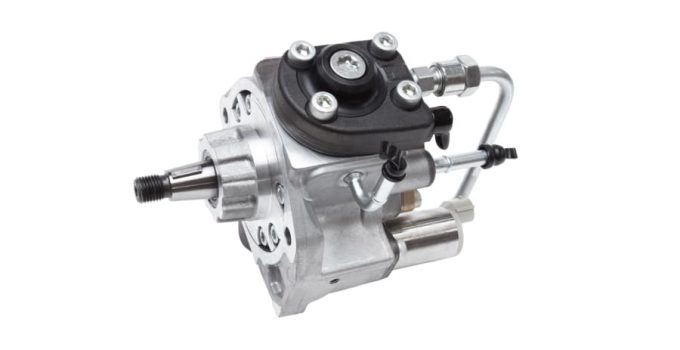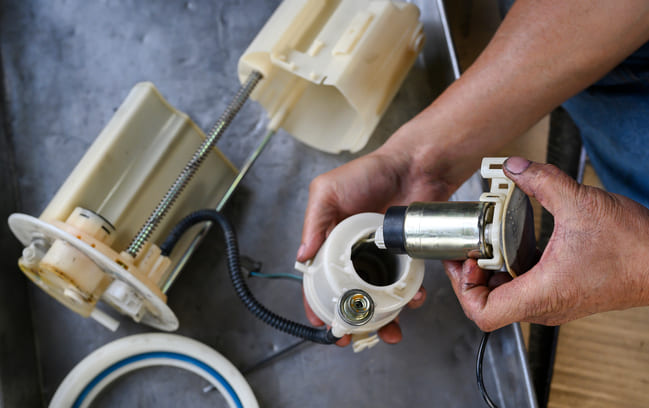
The purpose of the fuel pump in the car is to supply the engine injection with sufficient fuel. There are both petrol pumps and diesel pumps. The engine cylinders can then be supplied with the required amount of fuel so that it can be burned and finally the chemical energy contained is converted as much as possible into mechanical kinetic energy. State-of-the-art fuel pumps can achieve a service life of more than 10,000 operating hours, which is usually longer than the actual vehicle life. Ultimately, the actual service life of the component is also determined by the load, so that the corresponding wear processes can lead to premature failure. You now know the function of the fuel pump, but in the following article we also want to deal with its structure as well as possible defects and repair options.
Contents
Function and structure of mechanical and electric fuel pumps
In order to be able to recognize and understand what happens in the event of a defect, you should first of all understand the structure and the precise mode of operation of this vehicle system. In principle, both electrical and mechanical fuel pumps are used. As already described, the main purpose of the fuel feed pump is to supply the injection system with fuel. You should know that the amount of fuel actually transported – mostly petrol – is considerably larger than that actually injected. The petrol that was sucked in too much from the tank is fed back into the tank via a return line. Modern vehicle models have gone over to installing an integrated fuel delivery module. In addition to the fuel pump, this also consists of a float and is usually located at the rear end of the tank. Such a structure is also referred to as an in-tank pump. In contrast, what is known as an in-line pump, found on some models, is built inside the fuel line. While older vehicles still had pneumatic or mechanical fuel pumps, electric fuel pumps are used almost exclusively today. This is mainly due to the fact that such pumps are much easier to control – especially by the on-board electronics.
Symptoms of a faulty fuel pump
Now that you know how this system works and the basic structure, you can also understand the possible symptoms of a defect much better. Overall, diagnosing a fuel pump failure is considered difficult. One of the reasons for this is that it apparently does its job unnoticed and, all in all, is oversized. This also means that a slight drop in performance is hardly noticeable. For this reason, the symptoms of a broken fuel pump only appear sporadically or gradually. There may even be increasing and decreasing difficulties. However, if the fuel feed pump fails completely, this is easy to identify. In this case, however, it is best to have someone help you to check the fuel pump. He should keep his ear near the pump while you turn the ignition key to position two. This results in fuel being delivered for about two to three seconds, which your assistant can hear well. Overall, the symptoms of malfunction or declining performance include the following: poor engine starting, catastrophic engine failure, slight increase in fuel economy, poor engine and/or acceleration performance, engine judder and erratic acceleration.

In modern vehicles, the check engine light can also light up and a message can be found in the fault memory: „Insufficient fuel pump delivery“ or a similar one. In this case, there is either an uncontrolled loss of fuel (recognizable by spots under the vehicle) or the pumping capacity of the fuel feed pump is clearly too low. In some cases, you will also hear your fuel pump making noises, which can be taken as a sign of a defect.
Change the fuel pump

If there is a loss of performance due to a defect in the fuel pump, this component often has to be replaced. In some situations, however, it may be sufficient to first remove any blockages by cleaning. We would like to briefly explain how you can proceed in such a case using a few variants. First of all, however, you should consider that your fuel filter and the fuel pump itself are subjected to significantly greater stress, especially when driving with an empty tank. This is because the proportion of impurities in a less full tank is significantly higher than in a full tank. Therefore, regularly emptying the fuel tank puts a considerable strain on the fuel delivery system. In such a case, a special cleaning agent can provide the first remedy. This is usually referred to as a fuel system cleaner. Be sure to use such agents as required by the manufacturer's instructions. As a rule, the tank should be empty and at least the reserve light should come on. Then you fill in the fuel system cleaner before completely refilling your tank with fuel. Afterwards you should simply let your engine idle for at least a few minutes (preferably 10 to 15). You can then use your vehicle normally again. Cleaning the fuel pump filter can also help eliminate any problems; with some pumps, this filter can even be replaced.
However, if the measures described in the previous section do not remedy the situation, you will have to repair your fuel pump – i.e. replace it. Experienced screwdrivers can do this themselves with the necessary equipment. However, you should note that this is a rather expensive spare part, the installation of which needs to be carefully considered. First of all, you have to get a suitable replacement part so that you can mount it at all. Always observe normal safety precautions when working on the fuel system and also have a suitable fire extinguisher on hand if necessary. If possible, your tank should not be overfilled; this is especially true if your car has an in-tank pump. The first thing you should do is disconnect the starter battery before you disconnect and securely close the electrical connections and the fuel lines. Next, the fasteners must be loosened to remove the defective part; in the case of in-tank pumps, this is usually a very large nut. To loosen this black ring you need the so-called fuel gauge key. This is followed by the removal and positioning of the new spare part. It is important that you pay close attention to the fuel level sensor and its position. After the fuel lines have been reassembled, the electrical connections of the new part can also be restored. If you have concerns or do not trust yourself to do this work, please visit your specialist workshop.
Conclusion
A defective fuel feed pump is a long-lasting and difficult one component to be diagnosed. With a little experience and instinct, it is still possible to detect a defect. Experienced screwdrivers can replace this expensive component themselves; less experienced drivers are better off going to a specialist workshop.
A tip from CarTipsandmore: Only fill up with high-quality fuel and replace the relevant fuel filter at regular intervals. If you then avoid adding fuel only when the reserve light comes on, your fuel pump will probably do its job for a long time without complaint.
